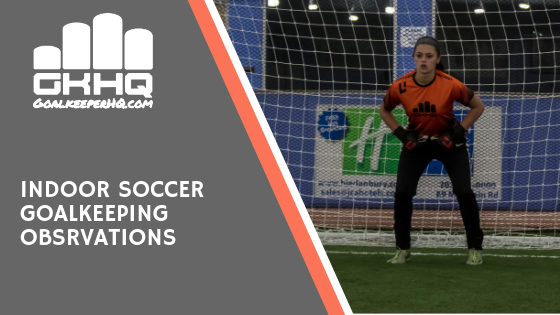Here are some thoughts from 9 years ago when I had been playing indoor soccer and wanted to give some tips to the goalkeepers I was coaching at the time.
Indoor tips
Having moved to the East Coast last November, I have been intrigued by the popularity of the indoor game and only having played outdoor or on hard gymnasium floors in England before I had to have a go. Having played last winter and this in both CT and Rhode Island, as well as refereeing and watching many other games in these areas, I see that there are some major differences in the position of goalkeeper. The intent to keep the ball out the net remains the same, but some of the techniques differ and I wanted to share my observations.
My first impression of the indoor game was that it should be easy as no longer do us goalkeepers have to defend a goal 8 ft high by 8 yards across, but in essence the boards ( when playing arena soccer in a rink ) and the speed of play are geared towards the indoor game being more offensive.
Please note that there are three types of indoor soccer. 1) Small sided version of the regular game 2) Arena soccer which is played in a rink with boards 3) Futsal, played on a hard court with slightly different rules to regular indoor soccer.
Observation 1 is that I have noticed that shooters generally aim high on near post shots and low on far post shots. I have therefore abandoned everything I have taught regarding set position of having hands together in order to be ready for a blocking save in either of these two shooting scenarios. I keep my arm closest to the post up on one side and the arm on the far side low.
Observation 2 – Links with the hand shapes in that during indoor games, we should not expect to make the perfect save and hold on to the ball. The reality is that the ball is coming at us so quick from a short distance and often through players that it is more important to make the initial block or parry. Those of you that have enjoyed the “Imperfect World” sessions I do will remember how I preach that the main objective is to be in the best position to save, and to lower expectations on catching and change to a parry or tip technique.
Observation 3 – It is very hard to make a save and adjust to be in the best position if you are on the floor. I have learnt that by staying on my feet as much as possible I force the shooter to make the play and I can still be in position if the ball rebounds off the boards to another shooter. When playing outdoor, we can take a chance on a diving save knowing that the ball can go out of bounds and we will gain possession.
Observation 4 – Vertical play to close down angles is an important way to stay on your feet and incorporate observation #3. The movements up and down is much quicker than in outdoor soccer and the goalkeepers attitude to moving feet must reflect this. Once you have closed down the angle, you should make use of the point blank save set position or be ready to save with feet.
Observation 5 – You have to be an outfield player with the ability to make saves. If you just stay in your goal, you are essentially playing with one less player. The goalkeeper needs to be the mini quarterback of the team, draw players towards them so that your team can become open. As a goalkeeper you must always be an option to support. These eliminates the need for team mates to force the play forward. Your starting position should also reflect your good support.
Observation 6 – The counter attack is crucial. By playing the ball quickly you can eliminate players from the other team to give a numerical advantage to your attacking team. This may be a 3 v 2 or 2 v 1 situation. In order to play quickly you need to a) have a game plan for when you catch cleanly b) get in behind the opposition players when you have caught it so they don’t get in your way c) Be prepared to dribble out of your box yourself to start the counter attack.
Here’s some examples of dribbling goalkeepers to inspire you.
https://youtu.be/H1Jwwoesc7w
Observation 7 – Know the rules. Every version of indoor soccer has variations of the rules and futsal, in particular has a different set of rules such as not being able to play back to the goalkeeper. The rules of each event may affect the way that you play, and you do not want to be responsible for letting up a goal because you were not aware of a particular rule.
